
Vanda, abbreviated in the horticultural trade as V., is a genus in the orchid family, Orchidaceae. There are about 87 species, and the genus is commonly cultivated for the marketplace. This genus and its allies are considered to be among the most specifically adapted of all orchids within the Orchidaceae. The genus is highly prized in horticulture for its showy, fragrant, long-lasting, and intensely colorful flowers. Vanda species are widespread across East Asia, Southeast Asia, and New Guinea, with a few species extending into Queensland and some of the islands of the western Pacific.

Phalaenopsis, also known as moth orchids, is a genus of about seventy species of plants in the family Orchidaceae. Orchids in this genus are monopodial epiphytes or lithophytes with long, coarse roots, short, leafy stems and long-lasting, flat flowers arranged in a flowering stem that often branches near the end. Orchids in this genus are native to India, Taiwan, China, Southeast Asia, New Guinea and Australia with the majority in Indonesia and the Philippines.

The flora consists of many unique varieties of tropical plants. Blessed with a tropical climate and roughly 17,000 islands, Indonesia is the nation with the second highest biodiversity in the world. The flora of Indonesia reflects an intermingling of Asian, Australian and unique, Indonesian lineages. This is due to the geography of Indonesia, located between the aforementioned continents. The archipelago consists of a variety of regions, from the tropical rain forests of the northern lowlands and the seasonal forests of the southern lowlands through the hill and mountain vegetation, to subalpine shrub vegetation. With the second longest coastline in the world, Indonesia also has many swamps and other varieties of coastal vegetation. Combined, these all give rise to a huge floral biodiversity. There are about 28,000 species of flowering plants documented in Indonesia, including 2500 orchids, 122 species of bamboo, over 350 species of rattan and 400 species of Dipterocarpus, including ebony, sandalwood and teakwood. Indonesia is also home to some unusual species of carnivorous plants. One exceptional species is known as Rafflesia arnoldi, named after Sir Thomas Stamford Raffles and Dr. Thomas Arnold, who discovered the flower in the depths of Bengkulu, southwest Sumatra. This parasitic plant has the largest flower of any plant, does not produce leaves and grows only on one species of liana on the rainforest floor. Another unusual plant is Amorphophallus titanum from Sumatra. Numerous species of insect trapping pitcher plants can also be found in Borneo, Sumatra, and other islands of the Indonesian archipelago. There are a staggering 6000 traditional medicinal plants used as Jamu.,
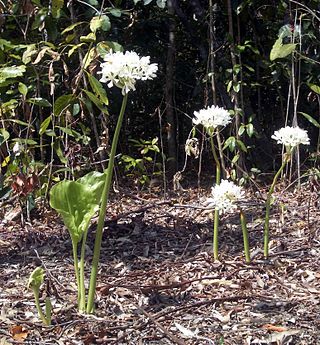
Proiphys amboinensis was named after the island of Ambiona, now Ambon, in Indonesia. Common names include Cardwell lily and northern Christmas lily. It is considered native to Thailand, Indonesia, the Philippines, the Bismark Archipelago, Vanuatu, New Guinea, Queensland and Western Australia. Is also naturalized in Seychelles, Sri Lanka, Solomon Islands, Niue, Society Islands, Caroline Islands and Mariana Islands.
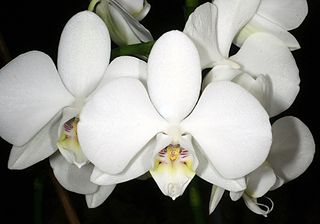
Phalaenopsis amabilis, commonly known as the moon orchid or moth orchid in India and as anggrek bulan in Indonesia, is a species of flowering plant in the orchid family Orchidaceae. It is native to the Indonesia and Australia, and widely cultivated as a decorative houseplant. It is an epiphytic or lithophytic herb with long, thick roots, between two and eight thick, fleshy leaves with their bases hiding the stem and nearly flat, white, long-lasting flowers on a branching flowering stem with up to ten flowers on each branch.

Dipodium, commonly known as hyacinth orchids, is a genus of about forty species of orchids native to tropical, subtropical and temperate regions of south-east Asia, New Guinea, the Pacific Islands and Australia. It includes both terrestrial and climbing species, some with leaves and some leafless, but all with large, often colourful flowers on tall flowering stems. It is the only genus of its alliance, Dipodium.

Robiquetia, commonly known as pouched orchids, or 寄树兰属 , is a genus of flowering plants from the orchid family, Orchidaceae. Plants in this genus are epiphytes with long, sometimes branched, fibrous stems, leathery leaves in two ranks and large numbers of small, densely crowded flowers on a pendulous flowering stem. There are about eighty species found from tropical and subtropical Asia to the Western Pacific.

Dendrobium discolor, commonly known as antler orchid, is a species of epiphytic or lithophytic orchids in the family Orchidaceae, and are native to northern Australia, New Guinea, and part of Indonesia. It has cylindrical pseudobulbs, each with between ten and thirty five leathery leaves, and flowering stems with up to forty mostly brownish or greenish flowers with wavy and twisted sepals and petals.

Phalaenopsis gigantea is a species of orchid endemic to the island of Borneo and was first described in 1909. The specific epithet gigantea refers to the giant size of its leaves, which can grown over 60 cm in length on a mature plant. It is the largest known Phalaenopsis species.
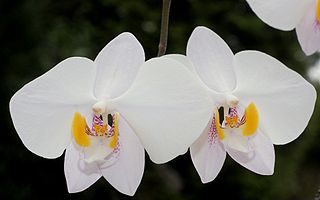
Phalaenopsis philippinensis is an endemic species of orchid found from Luzon island in the Philippines.

Phalaenopsis appendiculata is a species of miniature epiphyte in the family Orchidaceae, endemic to peninsular Malaysia.
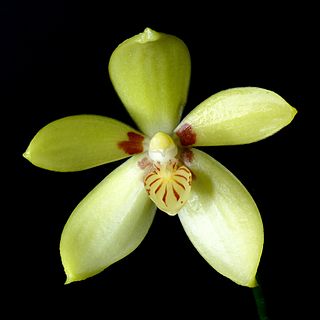
Phalaenopsis cochlearis is a species of orchid native to peninsular Malaysia to Borneo.

Phalaenopsis javanica is a species of orchid native to Java and Sumatra. The specific epithet javanica refers to the Indonesian island Java.

Phalaenopsis kapuasensis, also known as the Kapuas Hulu Phalaenopsis, is a species of orchid endemic to Borneo. The specific epithet kapuasensis refers to the indonesian locality Kapuas Hulu, from which the type specimen was obtained.

Phalaenopsis luteola is a species of orchid endemic to Borneo. The specific epithet luteola, from the Latin luteolus meaning "yellowish", refers to the floral colouration.

Phalaenopsis pantherina, also known as the panther-like Phalaenopsis, is a species of orchid endemic to Borneo. The specific epithet pantherina is derived from the leopard-like floral colouration.
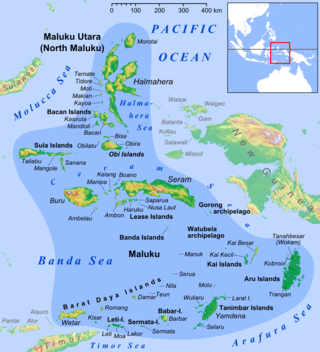
Phalaenopsis robinsonii is a species of orchid native to Maluku, Indonesia. The specific epithet robinsonii refers to the botanist and colector of the type specimen Charles Budd Robinson (1871-1913).

Phalaenopsis viridis is a species of orchid native to the Indonesian island Sumatra.

Phalaenopsis venosa, is a species of orchid endemic to Sulawesi, Indonesia. The specific epithet venosa, from the Latin venosus meaning veiny, refers to the floral colouration.



















